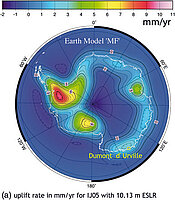Dumont d'Urville movements measured by Doris
Image of the Month - October 2009
One of the main uncertainties about climate change today is the reaction of polar caps, especially the Antarctic one. To solve this, the idea is to estimate the source of their movements, i.e. whether they are presently melting (or increasing), and/or reacting to the end of last glaciation (Glacial Isostatic Adjustement, which can lead to the rise of continents that were covered by ice, but also to the lowering of their margins).
Doris is a system that enables to precisely locate satellites on their orbit. It is also able to do so with ground tracking stations on Earth. Comparing the Doris measurements from a beacon located in Terre Adélie, near the Dumont d'Urville base (one of the Doris stations), and co-located measurements from GPS and gravity anomalies, an estimation of the displacements source is possible. Conclusions of this study lead to think that this East Antarctic region is mostly stable, with possibly a gain in ice mass (contrary to the West Antartic).
See also:
- Doris applications
- Applications / Ice: Doris measures a glacier's drift
- Applications / Ice: Speed of ice flow in Antarctica
Websites on this subject:
References:
- Amalvict, M., P. Willis, G. Wöppelmann, E.R. Ivins, M.-N. Bouin, L. Testut, J. Hinderer, 2009: Isostatic stability of the East Antarctic station Dumont d'Urville from long-term geodetic observations and geophysical models, Polar Research, 28, 2009, 193-202






